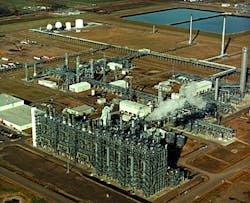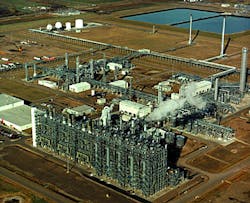Thi Chang
Refining/Petrochemical Editor
Dow Chemical Co. expanded its ethylene-production capacity at Fort Saskatchewan, Alta., from 1.2 to 2.4 billion lb/year in 1998. The ethylene produced from the expansion is being used in existing ethylene-based plants at the site, such as polyethylene and vinyl chloride monomer plants.Worldwide ethylene-capacity growth decreased sharply this year. Ethylene capacity increased by about 2.1 million metric tons/year (mty), or 2.5%, to 90.9 million mty.
Not including 1996, this figure is the slowest annual growth in ethylene capacity since 1990. Average growth in this decade has been about 5.3%/year.
The slowing growth in additional ethylene capacity reflects producers' recognition that there is an oversupply of ethylene in the market.
Capacity is not expected to increase significantly until 2000.
Corrections
For comparison purposes, this analysis includes the following corrections for last year's figures.In 1996, OGJ reported worldwide ethylene capacity at 89.6 million mty. Based on updated knowledge, the correct figure should have been 88.8 million mty. The following plants were deleted from the survey because they were listed twice in the former survey:
- Enichem's Dunkerque, France, ethylene plant, 310,000 mty
- Ina-Oki Ltd.'s Zagreb, Croatia, ethylene plant, 20,000 mty
- Keiyo Ethylene's Goi, Japan, ethylene plant, 525,000 mty
- Indian Petrochemicals Corp. Ltd.'s Nagothane, India, plant, 400,000 mty
Dow Chemical Europe's Terneuzen ethylene plant's capacity was corrected from 607,710 mty to 1.1 million mty (OGJ, Apr. 13, 1998, p. 39), and Yukong Ltd.'s Ulsan, South Korea, ethylene capacity has been corrected to 165,000 mty.
Capacity increases
Only one grassroots plant came on-line before Jan. 1, 1998, soon enough to be included in this year's ethylene survey. Formosa Plastics Corp. commissioned its 450,000 mty No. 6 naphtha cracker in Mailiao, Taiwan. (OGJ, Mar. 22, 1999, p. 52)Other significant capacity increases during the past year include:
- Dow Chemical Canada Inc. in Fort Saskatchewan, Alta., 544,220 mty
- Mobil Chemical Co. in Beaumont, Tex., 249,430 mty
- DSM NV in Geleen, The Netherlands, 100,000 mty
- Chevron Chemical Co. in Cedar Bayou, Tex., 90,700 mty.
New project plans
Usual project delays and unsteady economic environments delayed capacity expansions in 1998. In Indonesia, PT Trans-Pacific Petrochemical Industries suspended its plans to build a 700,000 mty ethylene plant in Tuban, East Java, Indonesia, which was to have been commissioned last year.According to the OGJ construction survey (OGJ, Oct. 5, 1998, p. 74), only about 3.0 million mty of ethylene capacity is expected to be added in 1999. Producers are hoping 2000 will be better, however. An additional 9.5 million mty of worldwide ethylene capacity is planned to be completed in the year 2000.
Undaunted by the economic situation in Asia, the Asia/Pacific region is planning about 1.3 million mty of additional capacity for 1999, excluding the before-mentioned East Java plant. South America is a distant second with about 720,000 mty of planned additional capacity.
The largest two ethylene projects planned in 2000 will be built in North America. Nova Chemicals Ltd. plans to commission a 1.3 million mty ethylene plant in May 2000 at its Joffre, Alta., complex.
BASF Corp. and Fina Inc. are building a single-train steam cracker in Port Arthur, Tex. (860,000 mty of ethylene and 860,000 mty of propylene). Their plant should be completed in the fourth quarter of 2000 (OGJ, Aug. 3, 1998, p. 31).
Capacity comparisons
The Asia/Pacific region had the highest percentage increase in capacity this year at 3.5%. This is down from the 1997-1998 increase of 9.3%.North America has the most regional ethylene capacity in the world, about 10 million mty more than the Asia/Pacific and Western Europe regions, and ranks second in growth. Ethylene capacity grew from 30.2 million mty to 31.1 million mty, or 3.1%.
Table 1 [12,859 bytes] summarizes the regional data based on this year's ethylene survey. National production capacities are listed in Table 2 [25,433 bytes]. Table 3 [10,773 bytes] lists the largest ethylene ownerships in the world. Dow Chemical Co. owns the largest amount of ethylene capacity in the world. The company owns about 5.4 million mty of ethylene capacity. Second is Equistar Chemicals LP.
In the U.S., Equistar is the largest ethylene producer with about 5.2 million mty of ethylene capacity, or 20% of U.S. capacity. At the end of March 1998, Occidental Petroleum Corp.'s assets added three new plants to Equistar, a total of about 1.7 million mty of ethylene capacity, to the previous Lyondell Petrochemical Co. and Millennium Chemicals Inc. joint venture.
In terms of largest cracker site for ethylene production, Phillips Petroleum Co.'s Sweeny, Tex., complex is the largest in the world with 2.0 million mty of ethylene production capacity. Table 4 [14,647 bytes] lists the 10 largest crackers in the world.
Ethylene market
Chem Systems, Tarrytown, N.Y., presented its analysis on the petrochemical industry in an annual conference in Houston at the end of January. At that conference, Bruce H. Pickover, vice-president of Chem Systems, presented a paper on the ethylene market.According to Pickover, worldwide demand for ethylene has grown steadily in the past, and is expected to reach 140 million tons by 2010. Given the current capacity of 90.9 million mty and assuming an average utilization rate of 90%, an additional 55 million tons of capacity will be needed by 2010.
Fig. 1a [94,626 bytes] illustrates the predicted global demand, capacity, and utilization through 2010 based on Chem System's forecasts. U.S. forecasts are shown in Fig. 1b.
Pickover expects naphtha to play a larger part in global feedstock sources by 2005. Naphtha has made up about 50-52% of ethylene feedstock sources since at least 1992. Fig. 2a [74,637 bytes] shows that by 2005, naphtha may be responsible for about 55% of global ethylene production, at the expense of ethane and gas oil.
In the U.S., the same trend in cracker feedstock is expected. Ethane accounts for a little more than 50% of the U.S. feedstock, and Pickover expects this number to be reduced and displaced by additional naphtha use (Fig. 2b).
Copyright 1999 Oil & Gas Journal. All Rights Reserved.

